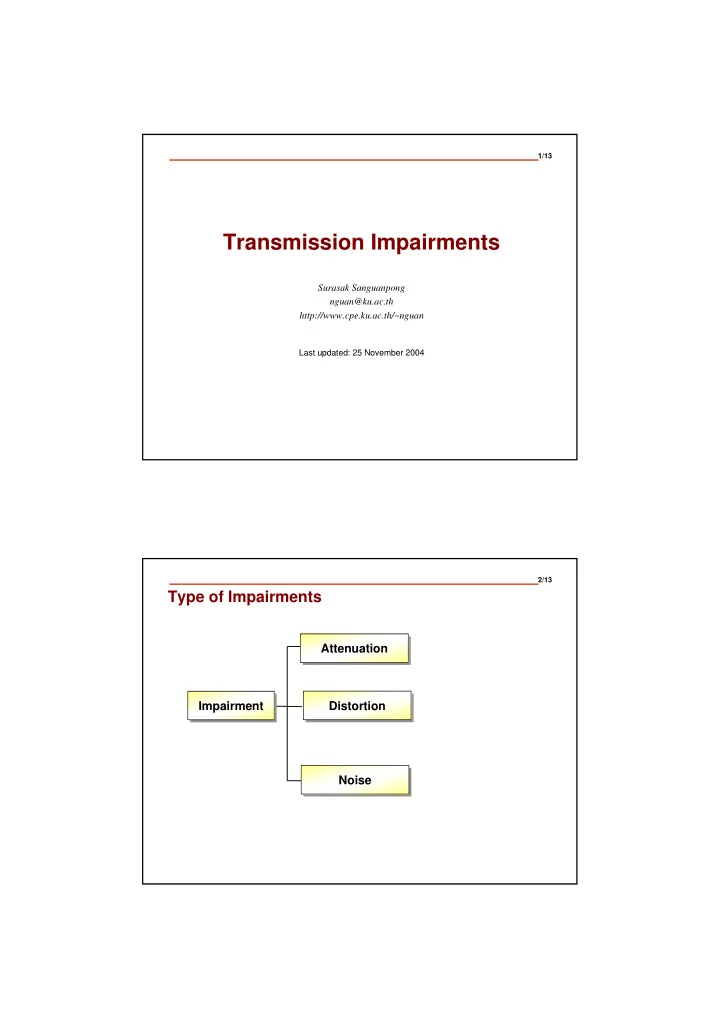

1/13 Transmission Impairments Surasak Sanguanpong nguan@ku.ac.th http://www.cpe.ku.ac.th/~nguan Last updated: 25 November 2004 2/13 Type of Impairments Attenuation Attenuation Impairment Distortion Impairment Distortion Noise Noise
3/13 Attenuation Transmitter Receiver Amplifier P 3 P 1 P 2 P 4 4/13 Decibel Amplifier 3 2 1 P = Power Attenuation 10 log 10 (P 2 /P 1 ) dB Gain 10 log 10 (P 3 /P 2 ) dB Typical Decibel Values Decibel is a base 10 � Power ratio Decibel Value Power ratio Decibel Value logarithmic measure 1 0 1 0 The gain and attenuation of � 2 3 2 3 a system are defined by the 4 6 4 6 ratio of the output power 8 9 8 9 over the input power 10 10 10 10 100 20 100 20 1000 30 1000 30
5/13 Distortion Received signal Original signal Transmitter Receiver Components are in phase Components are out of phase 6/13 Effect of noise Signal Noise Signal+Noise Sampling times 0 1 1 1 1 0 0 0 0 1 Data Received 0 1 0 1 1 0 0 1 0 1 Original data Bit error
7/13 Noise types � Atmospheric Noise � Lightning : static discharge of clouds � Solar noise : sun ’ s ionized gases � Cosmic noise : distant stars radiate high frequency signal � Gaussian Noise � Thermal noise : generated by random motion of free electrons � Crosstalk � NEXT � FEXT � Impulse Noise : sudden bursts of irregularly pulses 8/13 Noise � Effect � distorted a transmitted signal � attenuated a transmitted signal � signal-to-noise ratio to quantify noise S S = average signal power SNR dB = 10 log 10 N N = noise power
9/13 Bit Error Rate � The BER (Bit Error Rate) is the probability of a single bit being corrupted in a define time interval � BER of 10 -5 means on average 1 bit in 10 -5 will be corrupted � A BER of 10 -5 over voice-graded line is typical. � BERs of less than 10 -6 over digital communication is common. 10/13 Crosstalk NEXT FEXT � NEXT (near-end crosstalk) � interference in a wire at the transmitting end of a signal sent on a different wire � FEXT (far-end crosstalk) � interference in a wire at the receiving end of a signal sent on a different wire
11/13 Nyquist formula W = bandwidth in Hz C = 2W log 2 M M = number of discrete signal Theoretical capacity for Noiseless transmission channel Example: A noiseless 3KHz channel cannot transmit binary (two-level) signal at a rate exceeding 6000 bps M Max data rate (C) M Max data rate (C) Channel capacity 2 6000 bps 2 6000 bps calculation for voice 4 12000 bps 4 12000 bps bandwidth (3000 Hz) 8 18000 bps 8 18000 bps 16 24000 bps 16 24000 bps 12/13 Shannon Capacity A theorem that describes a model fot determining the maximum data rate of a noisy, analog communications channel. W = bandwidth in Hz W log 2 (1+ S N ) C = S = average signal power in watts N = random noise power in watts Sample Calculation for a telephone line Bandwidth = 3300-300 Hz = 3000 Hz Typical SNR = 35 dB, thus S/N=3162 C = 3000xlog2 (1+3162) = 34881 bps
13/13 Performance Throughput Transmitter Receiver 0101110101010111110 010110101111111 Throughput = Number of bits passing through in a second Propagation delay & propagation speed distance=D Transmitter Receiver 0101110 0101110 t 1 t 2 propagation delay = t 2 -t 1 = D/propagation speed
Recommend
More recommend